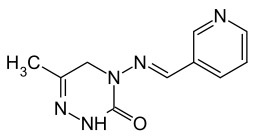
Contact us @ +91-98458 50494
Our Products
- Abamectin
- Acephate
- Acetamaprid
- Alpha Cypermethrin
- Bendiocarb
- Bifenthrin
- Buprofezin
- Chlorantraniprole
- Chlorfenapyr
- Chlorpyriphos
- Clothiandian
- Cyantraniliprole
- Cypermethrin
- Deltamethrin
- Diafenthiuron
- Diflubenzuron
- Dinotefuran
- Emamectin Benzoate
- Etoxazole
- Fenpyroximate
- Fipronil
- Hexaconozole
- Hexaflumuron
- Imidachloprid
- Indaxocarb
- Lambda Cyhalothrin
- Lufenuron
- Nitenpyram
- Ozamyl
- Profenofos
- Pymetrozine
- Spirodiclofen
- Thiamethoxam
- Tolfenpyrad
- Triazophos
- 6 Benzylaminopurine
- Brassionalide
- Chlormequat Chloride
- CPPU TC
- Diamonozide
- Giberllic Acid
- Natural Brassinolide
- Sodium Nitrophenalate
- Naphthylacetic Acid
- Indoleacetic Acid
- Naphthyl Acetamide
- Napthoxyacetic Acid
- Diethyl Aminoethyl Hexanoste
- Triacontanol(TRIA)
- 6-Furfurylaminopurine
- Forchlorfenuron
- Trans-Zeatin
- Regulox (Maleic hydrazide)
- Mepiquat chloride
- Thidiazution(TDZ)
- Gibberellic Acid
Our Products- Insecticides
Pymetrozine
 Pymetrozine 92%TC,
Pymetrozine 92%TC,
Pymetrozine 50% WDG
Common name pymetrozine (BSI, pa E-ISO)
IUPAC name (E)-4,5-dihydro-6-methyl-4-(3-pyridylmethyleneamino)-1,2,4-triazin-3(2H)-one
Chemical Abstracts name (E)-4,5-dihydro-6-methyl-4-[(3-pyridinylmethylene)amino]-1,2,4-triazin-3(2H)-one
CAS RN [123312-89-0] Development codes CGA 215944 (Ciba-Geigy)
APPLICATIONS
Biochemistry Novel, unidentified biochemistry. Mode of action Insecticide selective against Homoptera, causing them to stop feeding. Uses Control of aphids and whitefly in vegetables, potatoes, ornamentals, cotton, deciduous and citrus fruit, tobacco, hops; both juvenile and adult stages are susceptible. Also control of planthoppers in rice. Application rates vary from 150 g/ha on potatoes to 200-300 g/ha on ornamentals, tobacco and cotton; 10-30 g/hl on vegetables, fruit and hops. Formulation types DP; GR; WP; WG.
ANALYSIS
Residue determination by hplc and u.v. detection. Details available from Syngenta. Pymetrozine: MAMMALIAN TOXICOLOGY
Oral Acute oral LD50 for rats 5820 mg/kg. Skin and eye Acute percutaneous LD50 for rats >2000 mg/kg. Non-irritating to the skin and eyes (rabbits). Not a skin sensitiser to guinea pigs. Inhalation LC50 (4 h) >1800 mg/m3 air. NOEL (2 y) for rats 3.7 mg/kg b.w. daily. ADI 0.03 mg/kg b.w. Other Non-mutagenic in 5 assay tests including the Ames test. Toxicity class WHO (a.i.) III
Pymetrozine: ECOTOXICOLOGY
Birds Acute oral LD50 for bobwhite quail, mallard ducks >2000 mg/kg. LC50 (8 d) for bobwhite quail >5200 ppm. Fish LC50 (96 h) for rainbow trout and common carp >100 mg/l. Daphnia LC50 (48 h) 87 mg/l. Algae LC50 (72 h) for Scenedesmus subspicatus 47.1 mg/l; LC50 (5 d) for Selenastrum capricornutum 21.7 mg/l. Bees LD50 (48 h) (oral) >117 mg/bee; (contact) >200 mg/bee. Worms LC50 (14 d) for Eisenia foetida 1098 mg/kg soil. Other beneficial spp. Harmless to Aleochara bilineata, Poecilus cupreus, Typhlodromus pyri, Orius insidiosus, Aphidius colemani, Aphidius matricariae, Chrysoperla carnea.
ENVIRONMENTAL FATE
Animals Quickly and efficiently eliminated (mainly via excreta) and extensively metabolised in all species tested (rats, farm animals), without accumulation in most major animal food products. The metabolic pathways are similar for all species. Pymetrozine is the relevant residue for assessing the consumer exposure to treated animal food products. Plants The basic degradation steps are similar in all investigated crops; pymetrozine is the only relevant compound for residue definition. Soil/Environment In soils, very rapidly and strongly adsorbed, with low mobility and low leaching potential. Soil DT50 2-69 d, DT90 55-288 d. Rapidly degraded in slightly acidic or sunlight-exposed surface water; DT50 in surface water (typical value) 7 d. Slightly volatile. Efficiently removed by direct photolysis and photochemically induced oxidation.
STRUCTUREAL FORMULA |
|
Alleghenies |
|
Name |
Pymetrozin |
AndereNamen |
|
Summenformel |
C10H11N5O |
CAS-Nummer |
123312-89-0 |
PubChem |
9576037 |
Kurzbeschreibung |
beiger Feststoff |
Molare Masse |
217,23 g·mol |
Aggregatzustand |
fest |
Dichte |
1,36 g·cm |
Schmelzpunkt |
216 °C (Zersetzung) |
Lösl ichkeit |
sehrschwerlöslich in Wasser(0,29 g·l−1 bei 25 °C) löslich in Dichlormethan,Essigsäureethylester AND Ethanol |
